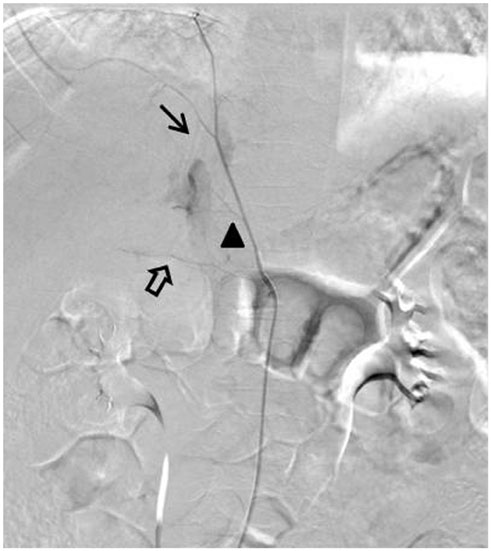J Korean Soc Radiol.
2016 Dec;75(6):508-511. 10.3348/jksr.2016.75.6.508.
Endovascular Treatment of a Post-Traumatic Adrenal Hemorrhage in a Pediatric Patient: A Case Report
- Affiliations
-
- 1Department of Radiology, Busan Paik Hospital, Inje University College of Medicine, Busan, Korea. bighiva@hanmail.net
- KMID: 2360440
- DOI: http://doi.org/10.3348/jksr.2016.75.6.508
Abstract
- Adrenal hemorrhage following blunt trauma is a rare occurrence. We report here the case of a 5-year-old child with adrenal hemorrhage, which developed as a result of an accidental fall. Embolization treatment of adrenal hemorrhage was successfully performed. To the best of our knowledge, this is the first report of adrenal hemorrhage occurring in a child which was treated with transcatheter embolization.
MeSH Terms
Figure
Reference
-
1. Dinc H, Sims¸ek A, Ozyavuz R, Ozgür GK, Gümele HR. Endovascular treatment of massive retroperitoneal haemorrhage due to inferior adrenal artery injury. A case report. Acta Radiol. 2002; 43:326–328.2. Agrawal N, Rao S, Zellweger R, Knight T. Adrenal pseudoaneurysm due to blunt trauma. Indian J Surg. 2013; 75:Suppl 1. 155–157.3. Gabal-Shehab L, Alagiri M. Traumatic adrenal injuries. J Urol. 2005; 173:1330–1331.4. To'o KJ, Duddalwar VA. Imaging of traumatic adrenal injury. Emerg Radiol. 2012; 19:499–503.5. Roupakias S, Papoutsakis M, Mitsakou P. Blunt adrenal gland trauma in the pediatric population. Asian J Surg. 2011; 34:103–110.6. Copes WS, Champion HR, Sacco WJ, Lawnick MM, Keast SL, Bain LW. The Injury Severity Score revisited. J Trauma. 1988; 28:69–77.7. Sivit CJ, Ingram JD, Taylor GA, Bulas DI, Kushner DC, Eichelberger MR. Posttraumatic adrenal hemorrhage in children: CT findings in 34 patients. AJR Am J Roentgenol. 1992; 158:1299–1302.8. Choi SJ, Kim JE, Ryu Il, Kim JJ, Choi HY. MDCT findings of traumatic adrenal injury in children. J Korean Soc Radiol. 2011; 64:191–195.9. Fowler AM, Burda JF, Kim SK. Adrenal artery embolization: anatomy, indications, and technical considerations. AJR Am J Roentgenol. 2013; 201:190–201.10. Rammelt S, Mucha D, Amlang M, Zwipp H. Bilateral adrenal hemorrhage in blunt abdominal trauma. J Trauma. 2000; 48:332–335.
- Full Text Links
- Actions
-
Cited
- CITED
-
- Close
- Share
- Similar articles
-
- A Case of Traumatic Bilateral Adrenal Hemorrhage Mimicking Bilateral Adrenal Adenomas
- Recurrent Post-Traumatic Adrenal Bleeding after Transcatheter Arterial Embolization: A Case Report
- A Case of Spontaneous Adrenal Hemorrhage in an Adult
- Cerebral Hemorrhage after Endovascular Treatment of Bilateral Traumatic Carotid Cavernous Fistulae with Covered Stents
- A Case of Improved Adrenal Insufficiency with Corticostreoid Treatment, Secondary to Adrenal Hemorrhage




